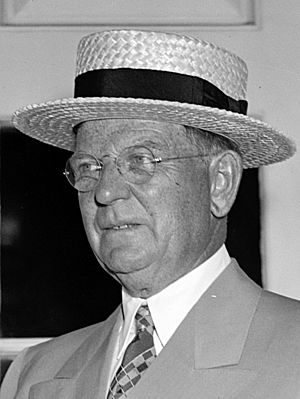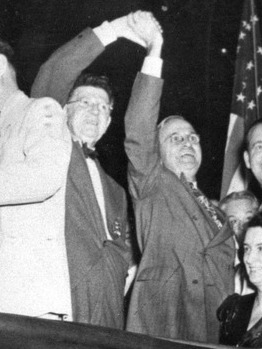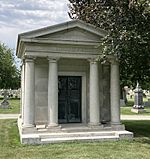Edward Joseph Kelly facts for kids
Quick facts for kids
Edward Joseph Kelly
|
|
|---|---|

Mayor Kelly in 1937
|
|
| 46th Mayor of Chicago | |
| In office April 17, 1933 – April 15, 1947 |
|
| Preceded by | Frank J. Corr |
| Succeeded by | Martin H. Kennelly |
| Chairman of the Cook County Democratic Party | |
| In office 1943–1946 |
|
| Preceded by | Patrick Nash |
| Succeeded by | Jacob Arvey |
| 6th President of the United States Conference of Mayors | |
| In office 1945–1947 |
|
| Preceded by | Fiorello La Guardia |
| Succeeded by | George W. Welsh |
| Personal details | |
| Born |
Edward Joseph Kelly
May 1, 1876 Chicago, Illinois, United States. |
| Died | October 20, 1950 (aged 74) Chicago, Illinois, U.S. |
| Resting place | Calvary Cemetery |
| Political party | Democratic |
| Spouses |
Mary E. Roche
(m. 1910; died 1918)Margaret E. Kirk
(m. 1922–1950) |
| Children | 4 |
| Residences | Chicago, Illinois |
Edward Joseph Kelly (May 1, 1876 – October 20, 1950) was an American politician. He served as the 46th Mayor of Chicago. His time as mayor lasted from April 17, 1933, to April 15, 1947.
Before becoming mayor, Kelly worked as the chief engineer for the Chicago Sanitary District. This was during the 1920s.
Contents
Early Life and Career
Edward Kelly was born in Chicago's South Side, in a neighborhood called Bridgeport. His father, Stephen, was a police officer. Edward was the first of five Chicago mayors to come from Bridgeport.
He did not finish grammar school. Instead, he started working at age ten. In the 1920s, Kelly became the chief engineer of the Chicago Sanitary District. He was supported by Patrick Nash, who owned a company that worked on sewers for the city.
Political Career
Leading the South Park Commission
In March 1924, Kelly became the president of the South Park Commission. This group was in charge of parks and public spaces in the southern part of Chicago.
He oversaw the finishing and opening of Soldier Field. This famous stadium was built and run by the South Park Commission. Kelly used the venue for many public events and fundraisers. These events often supported charities and groups linked to the Democratic Party.
Mayor of Chicago (1933–1947)

After Mayor Anton Cermak passed away, Edward Kelly was chosen to be the next mayor. His friend, Patrick Nash, who led the Cook County Democratic Party, helped him get the position. Together, Kelly and Nash created a very strong political group in Chicago. It was known as the "Kelly-Nash Machine."
Kelly was mayor during the 1933–34 Chicago World's Fair, called "A Century of Progress." This fair happened during the Great Depression. He helped start the first official Major League Baseball All-Star Game as part of the fair.
Mayor Kelly was also known for banning a book called Never Come Morning by Nelson Algren in 1942. The ban stayed in place for many years because of strong reactions from the Polish community in Chicago.
From 1945 to 1947, Kelly was the president of the United States Conference of Mayors. This group helps mayors across the country work together.
In 1937, Chicago received money from the Works Progress Administration (WPA). The WPA was a government program that created jobs during the Great Depression. This funding helped start building Chicago's first subway system. The groundbreaking for the State Street subway happened on December 17, 1938. Kelly also got WPA money for other projects. These included improving Midway Airport and fixing city roads.
In 1945, a report criticized the Chicago Public Schools. It said that politics were too involved in how the schools were run. In response, Mayor Kelly formed a special committee in 1946. This committee was led by Henry Townley Heald. Kelly promised to follow their advice. The committee suggested changes to school laws. They also asked the school superintendent and the entire Chicago Board of Education to resign. Kelly accepted most of their ideas. Many school board members did resign, and new members were chosen based on the committee's recommendations.
During Kelly's time as mayor, the city was able to combine all public transportation. This led to the creation of the Chicago Transit Authority.
End of His Time as Mayor
In 1947, the Cook County Democratic Party decided to choose a new candidate for mayor. This new candidate, Martin H. Kennelly, was known for wanting reforms. Kelly agreed with this decision and was succeeded by Kennelly.
At the time of his death, Kelly was serving as a Democratic National Committeeman for Illinois.
Death
Edward Kelly passed away in 1950 at the age of 74. He was buried in Calvary Cemetery in Evanston, Illinois.
See also
- Timeline of Chicago, 1930s-1940s


